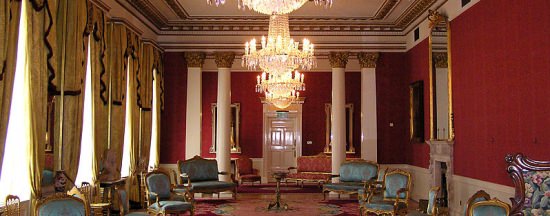Dublin Castle operated in the past (for 700 years) as a military fortress, a prison, a treasury, the courts of law and the seat of English administration in Ireland.
The State Apartments dominate the south range of the Great Courtyard. They were built as the residential and public quarters of the Viceregal Court and were the seat of the executive and focus of fashionable and extravagant social life. Today the Apartments are the venue for Ireland’s Presidencies of the European Union, for Presidential inaugurations and for prestigious functions.
The Undercroft is sited at lower ground floor level in the Lower Castle Yard, opposite the Chapel Royal. The city walls join the Castle at this point. Here, the archway allowed small feeder boats to land provisions at the postern gate, from larger boats moored on the Liffey. The double archway and postern gate are still visible. Also on view here is the Viking defence bank, within the butt of the Norman Powder Tower. The original Tower was five stories high – the top storey being occupied by the Lord Deputy during the 16th century.
The Chapel Royal is a gothic revival building designed by Francis Johnston. It is famous for its vaulting, its particularly fine plaster decoration and carved oaks and galleries. Admission to the Chapel Royal is free.
Also on this site, in the Revenue Museum one can experience a unique window on the many and varied activities of the Revenue Commissioners, from tax collection to customs controls, over several centuries. In addition to exhibits old and new, the Museum (located in the Crypt of the Chapel Royal) contains audio-visual displays and instructive video games. See if you can find hidden contraband or guess the parts of a house that were subject to tax in days gone by.
Among the many exhibits are the first set of Exchequer Returns for Saorstát Éireann, a poitín still, a stamp duty machine, examples of counterfeit goods and endangered species seized at ports and airports, early computer technology, and a wide range of beautiful measuring instruments. All of these are housed in the atmospheric crypt of the Chapel Royal.
The Garda Museum and Archives are located at the Treasury Building, Dublin Castle. Here visitors will find an interesting exhibition about the history of An Garda Síochána and information on policing in Ireland before 1922. The museum exhibits include photographs and documents outlining the history and development of policing in Ireland in the 19th/20th centuries.
Opening Hours:
Open seven days a week 9.45am – 5.45pm, last admission 5.15pm.
The State Apartments, the Undercroft and the Chapel Royal are open during these hours. Guided tours run hourly from 10am-4pm, with tickets available online and at the venue. Self-guided or group tours can be booked in advance.
Revenue Museum is open weekdays from 10am to 4pm.
Garda Museum and Archives are open to the public weekdays from 10am to 2pm.
All attractions on this site are closed Good Friday, 25 – 27 December & 1 January.
As Dublin Castle is a working Irish Government building, security, access to rooms and opening arrangements may be subject to change at short notice.
Please check the website for updates before visiting.
Contact & Pricing:
dublincastle.ie
[email protected]
[email protected]
[email protected]
Tel: 046 942 2213 (General enquiries)
01 863 5601 (Revenue Museum)
01 666 9998 (Garda Museum)
Dame Street, Dublin 2
Adults from €8; concessions
